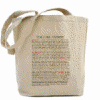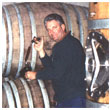
We're an all volunteer website and need your help to keep going. Here are five ways you can contribute: 1 Donate 2 Buy something 3 Submit a story 4 Volunteer 5 Advertise

New in the gift shop, virtualitalia.com logo wear and use items! 
|
PLEASE NOTE: We are experiencing unexpected
technical difficulties caused by our web host. We apologize for
the inconvenience. During your visit you may experience service
and page interruptions - we are in the process of fixing everything and hope to be
fully back on our feet soon.
[an error occurred while processing this directive]
white crush
While our yearly schedule may be somewhat predictable, the day-to-day work of making wine certainly isn't. What we did last year is not necessarily what we�ll do this year. Circumstances and variables change. We can�t take anything for granted. I�ve often commented that God is the winemaker, and that all we can do is work with what God�s given us. This is never truer than at harvest time. Michael, our son and winemaker, works alongside God every day, as he checks the vineyards to determine the ripeness of the grapes. Michael can�t pick the grapes when he�s ready to pick them; he has to pick at precisely the moment when God has decided that the grapes are ready to be picked. And it�s important to remember that ripe grapes will wait for no man. Our white grapes are the first to ripen, so Michael knows to keep a very close eye on them when September arrives. The grapes are best picked in the early morning hours, when the air is cool and the grapes are too. White grapes, especially, must be handled with expediency. They must be rushed to the cellar before they can become warm, because heat is the enemy of the delicateness that makes white wines special. We must also be careful to have enough equipment on hand to keep the grapes properly chilled. As we press the chilled grapes, using high-tech and highly programmable presses from Italy, we carefully avoid grinding or macerating the grapes, which would adversely affect the quality of the juice. Instead, we use tons of pressure to press the grapes, allowing the juice to filter itself as it runs through the solids left behind. The result of this dual effort � keeping the grapes chilled and using large, high-tech presses � ensures that the resulting juice is as clean and flavorful as possible. The juice is then pumped into a stainless steel tank and inoculated with yeast. Some delicately flavored whites (Muscat Canelli and Tocai Friulano, for instance) will remain in stainless steel until they are bottled in order to preserve their unique fruit flavors. Others, such as Pinot Grigio, Vernaccia, Arneis and Chardonnay, will be moved to a mix of new and aged barrels to gain additional flavors. Each barrel imparts unique characteristics to the wine, so we like to play around with different ones; our Pinot Grigio, for instance, is aged in three different types of barrels for added complexity. Since we don�t want the essence of wood to overpower our white wines, we�re judicious in selecting our barrels, opting for those with tight grain and light, even toasting. As the wine ferments in the tanks or barrels, the yeast multiplies and converts the sugars in the juice into carbon dioxide and alcohol. Eventually, the yeast hulls settle to the bottom of the tank or barrel, creating a sediment called lees. It was the French who first discovered that the lees impart desirable flavors, and you�ve probably heard the French term sur lie, which means allowing wine to ferment while sitting on the lees. Some winemakers prefer to stir the lees to impart even greater flavors. We, however, have adapted this method to best suit our own goals. Since we don�t want the lees characteristics to overpower the wine, we will often pump the wine from the tank or barrel, remove all the lees and return the wine to the tank or barrel with only a third of the original lees. We�ll then stir the lees � daily, weekly or infrequently, depending on the wine � until we get to the point that the wine has absorbed just the right amount of flavor without losing its inherent qualities. The key to making fine wines is to add just the right amount of extractions to enhance the inherent qualities of the grape without overwhelming them. My personal philosophy has always been that since we�re making wine from grapes, we should express the flavors of the grapes rather than using the grapes as a medium for other flavors. Above all, we want the essence of the grapes themselves to shine through. There is no exact formula to achieve this perfect balance of flavors. A technique that produced fabulous results last year may completely overpower this year�s wine. So we have to take each wine as it comes, relying upon our many years of experience and hoping for a little help from God, the other winemaker.
about the author |
© 1998-2005 by virtualitalia.com unless otherwise noted
 As winemakers, we�ve developed a pretty predictable schedule: We spend nine long months completing outdoor work before undertaking three intense months of indoor tasks. September marks the end of the outdoor and the beginning of the indoor, as we harvest our carefully tended grapes and bring them to the cellar for pressing. It�s time to trade our work boots and pickup trucks for stainless steel and high tech equipment.
As winemakers, we�ve developed a pretty predictable schedule: We spend nine long months completing outdoor work before undertaking three intense months of indoor tasks. September marks the end of the outdoor and the beginning of the indoor, as we harvest our carefully tended grapes and bring them to the cellar for pressing. It�s time to trade our work boots and pickup trucks for stainless steel and high tech equipment.
 A third-generation Sonoma Valley winemaker, Sam Sebastiani was born and raised in the heart of Sonoma. He spent his early years learning viticulture and enology from his father, August Sebastiani (1913-1980), a renowned California winemaker.
Founded in 1989 by Sam and Vicki Sebastiani, Viansa is their vehicle to share their love of good food, wine and their Italian heritage with visitors from around the world. Dedicated to the marriage of wine and food, Viansa (short for "Vicki and Sam") offers visitors a taste of Tuscany in Sonoma Valley. Today, this family-owned and operated winery is proud to be the premier producer of Italian varietals in the United States!
A third-generation Sonoma Valley winemaker, Sam Sebastiani was born and raised in the heart of Sonoma. He spent his early years learning viticulture and enology from his father, August Sebastiani (1913-1980), a renowned California winemaker.
Founded in 1989 by Sam and Vicki Sebastiani, Viansa is their vehicle to share their love of good food, wine and their Italian heritage with visitors from around the world. Dedicated to the marriage of wine and food, Viansa (short for "Vicki and Sam") offers visitors a taste of Tuscany in Sonoma Valley. Today, this family-owned and operated winery is proud to be the premier producer of Italian varietals in the United States!